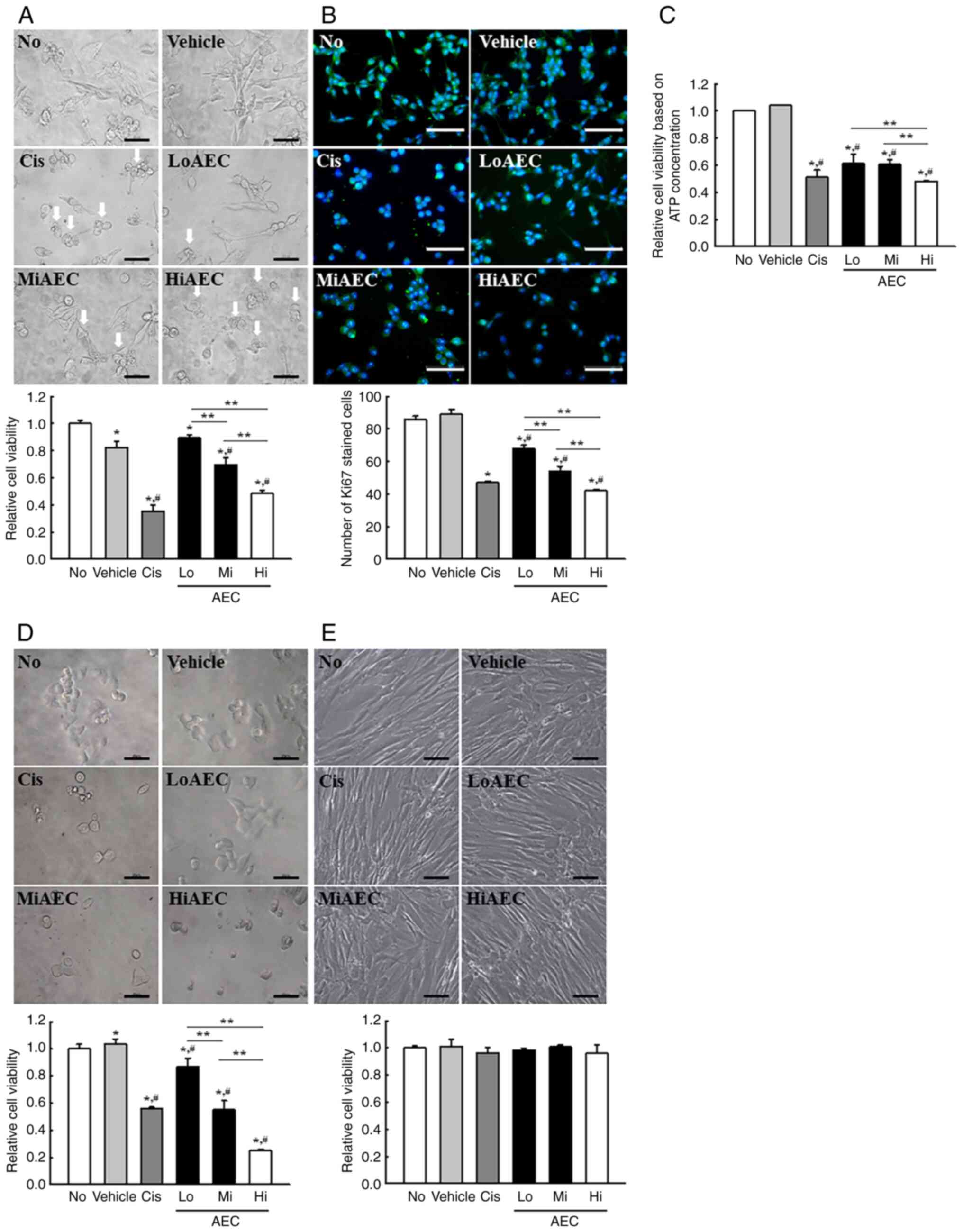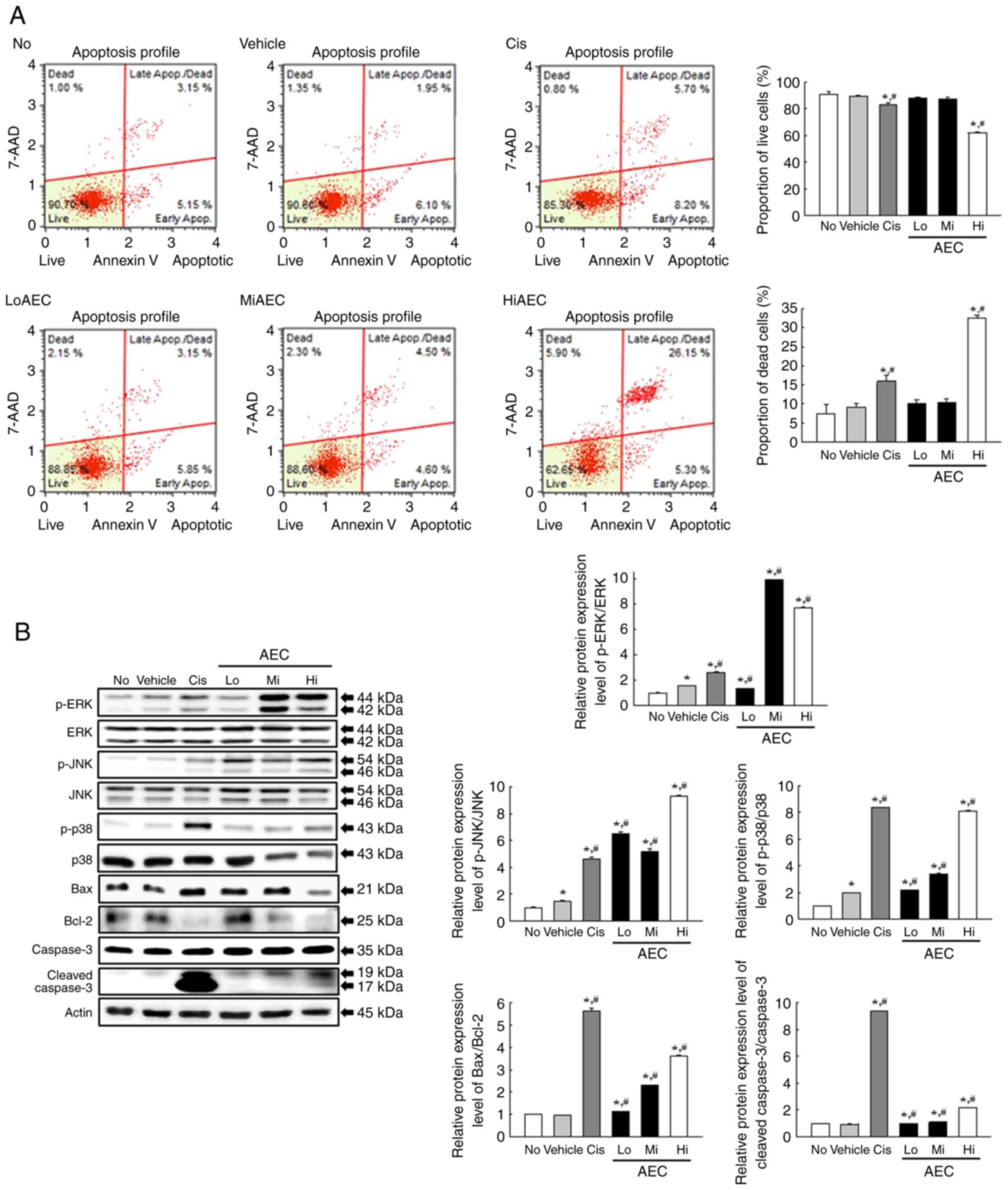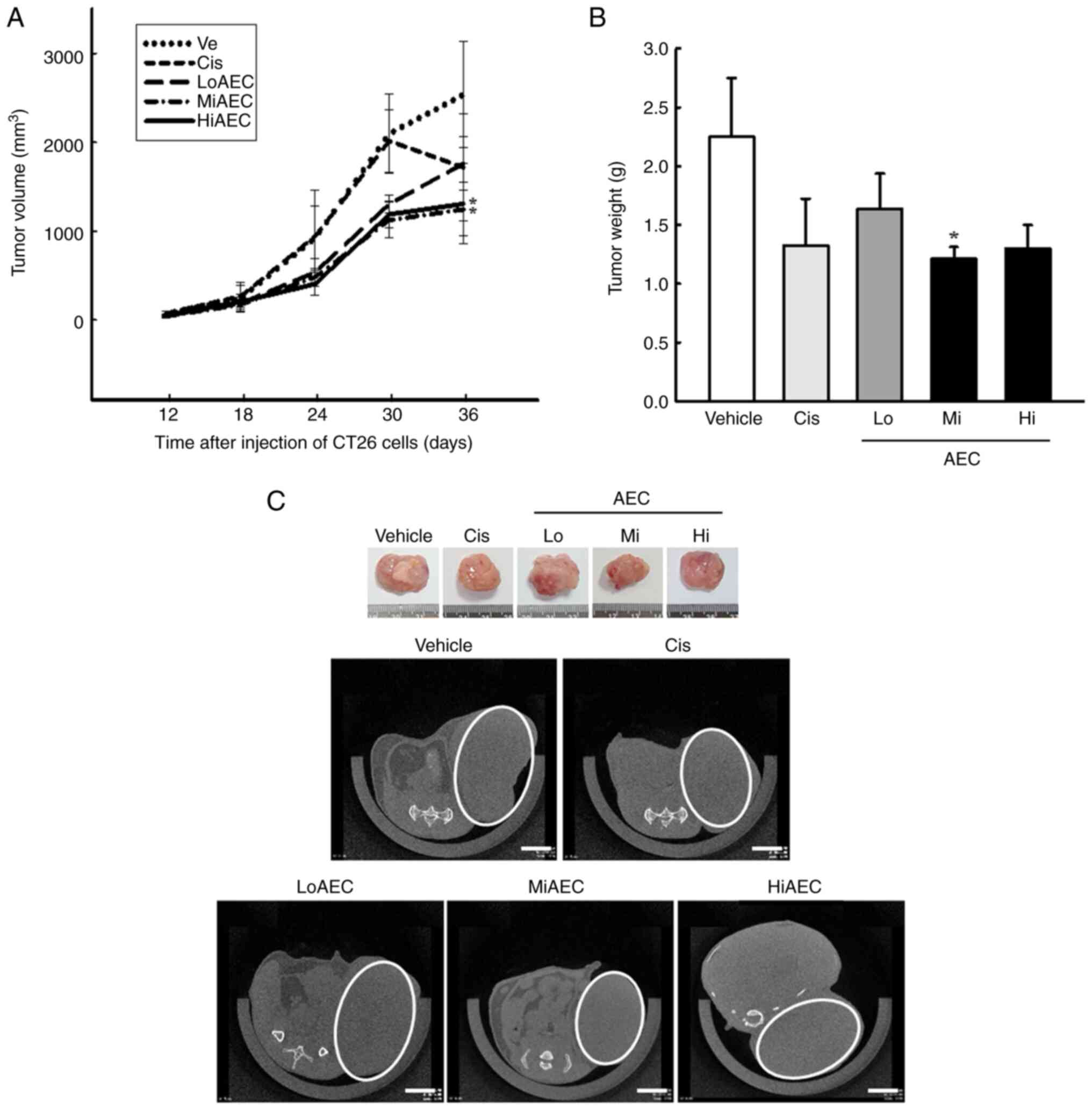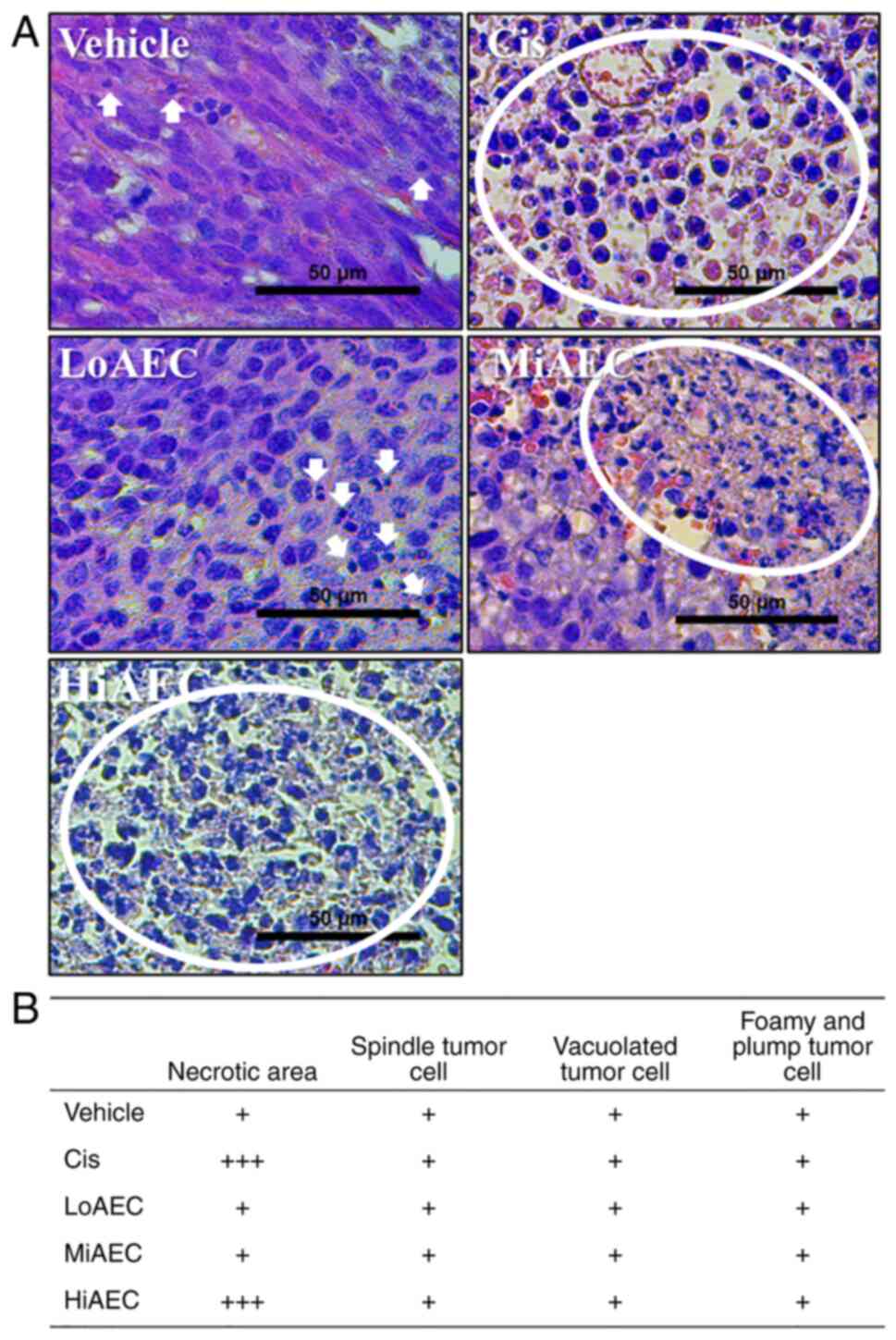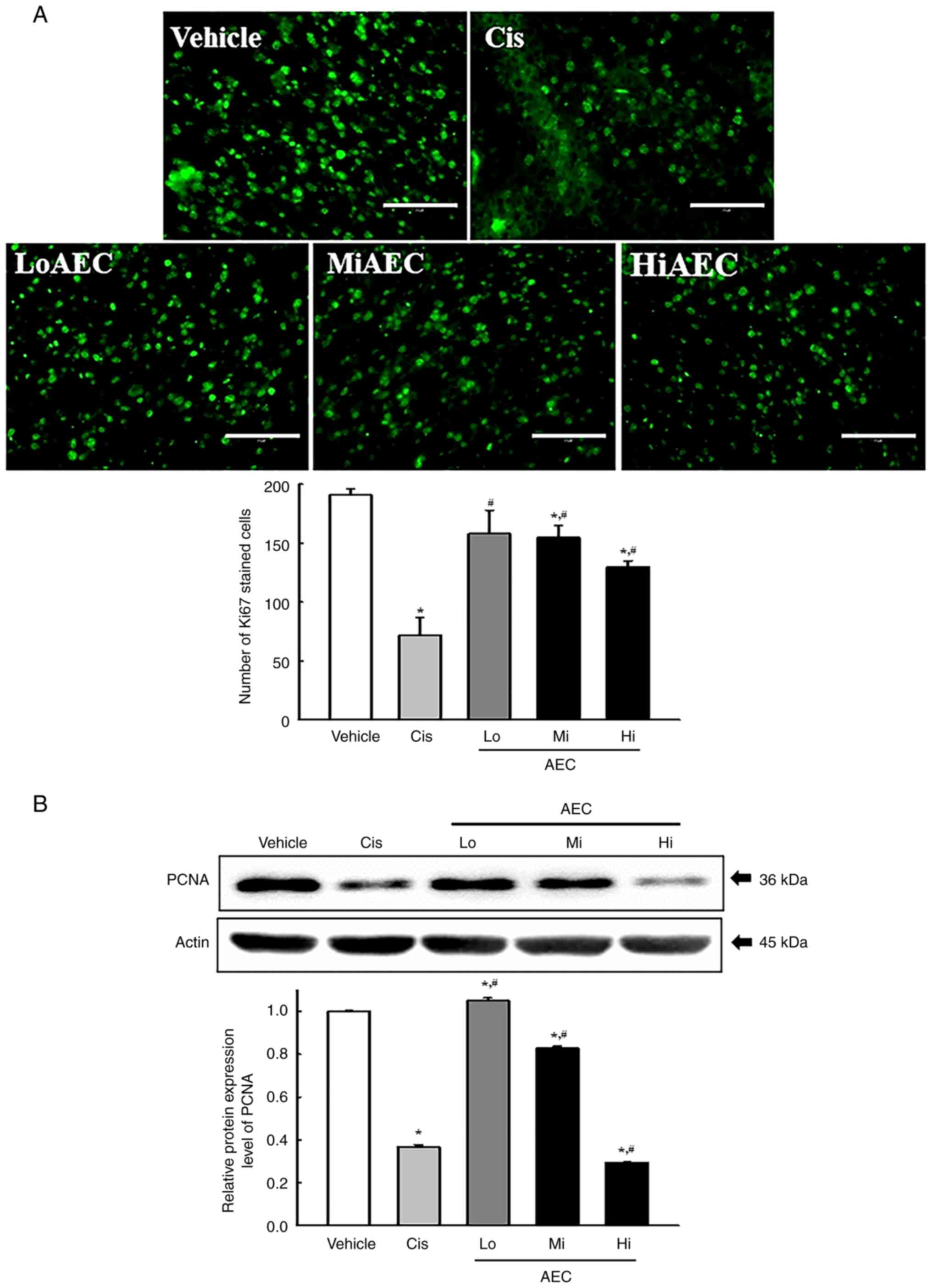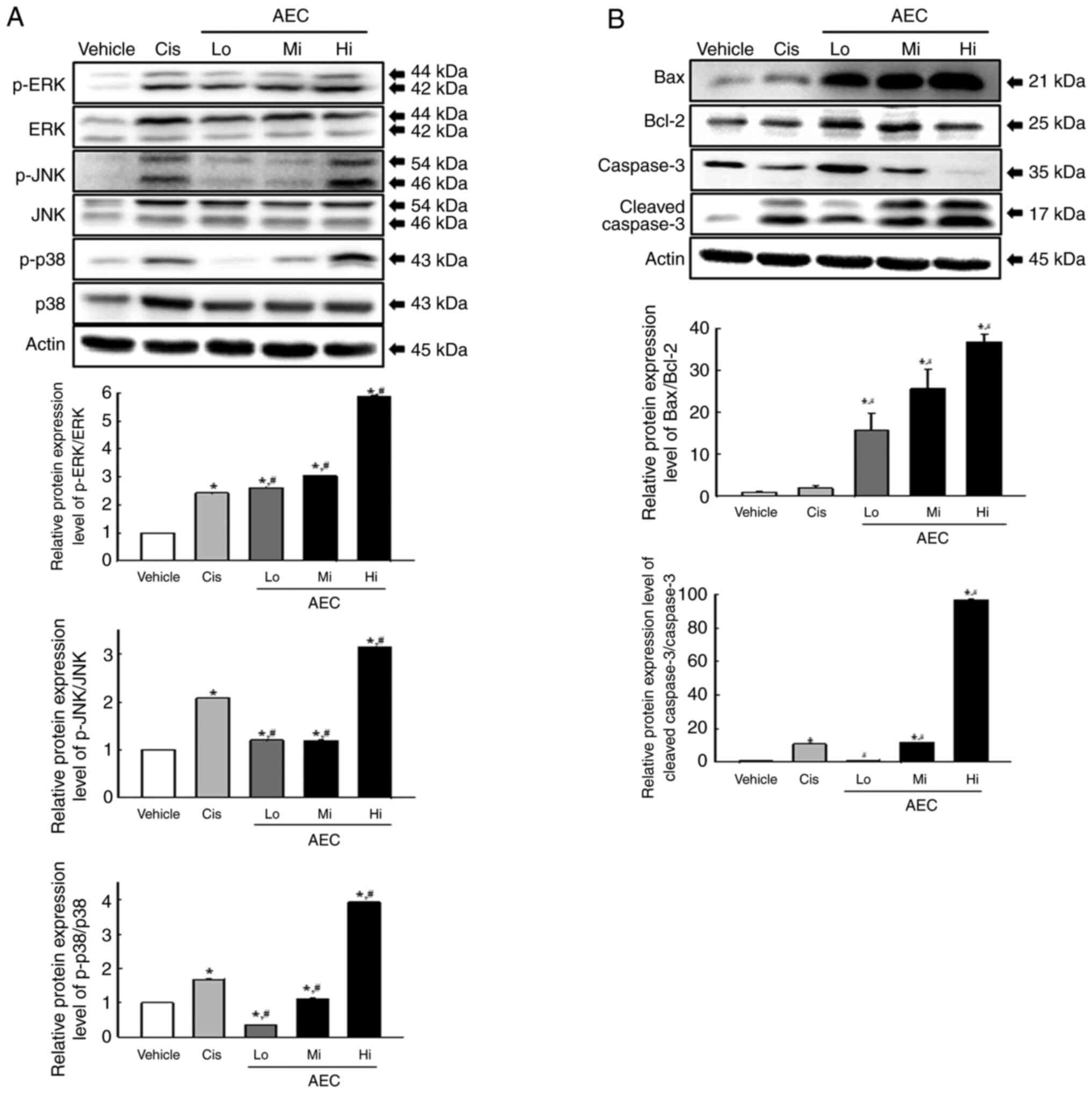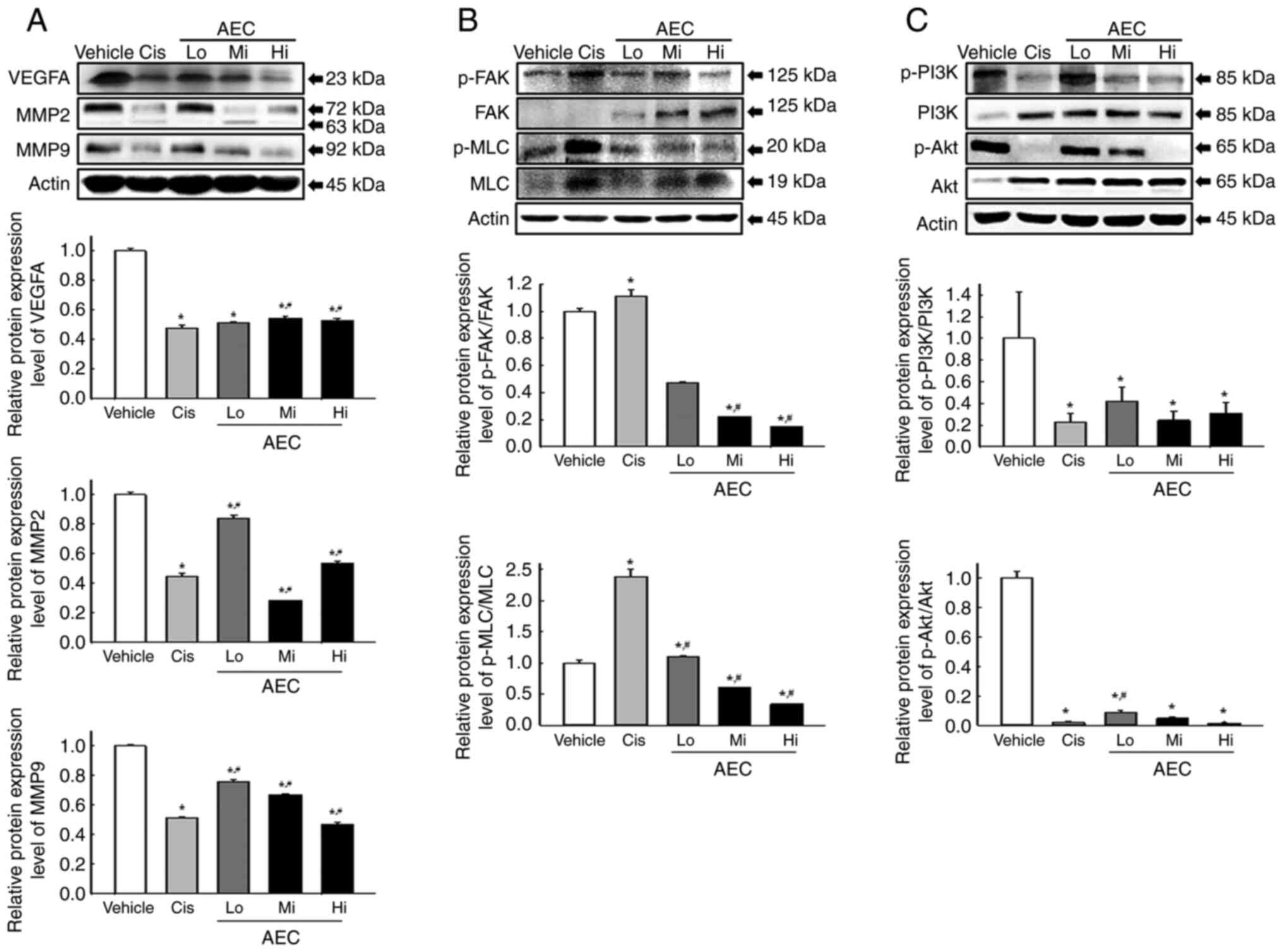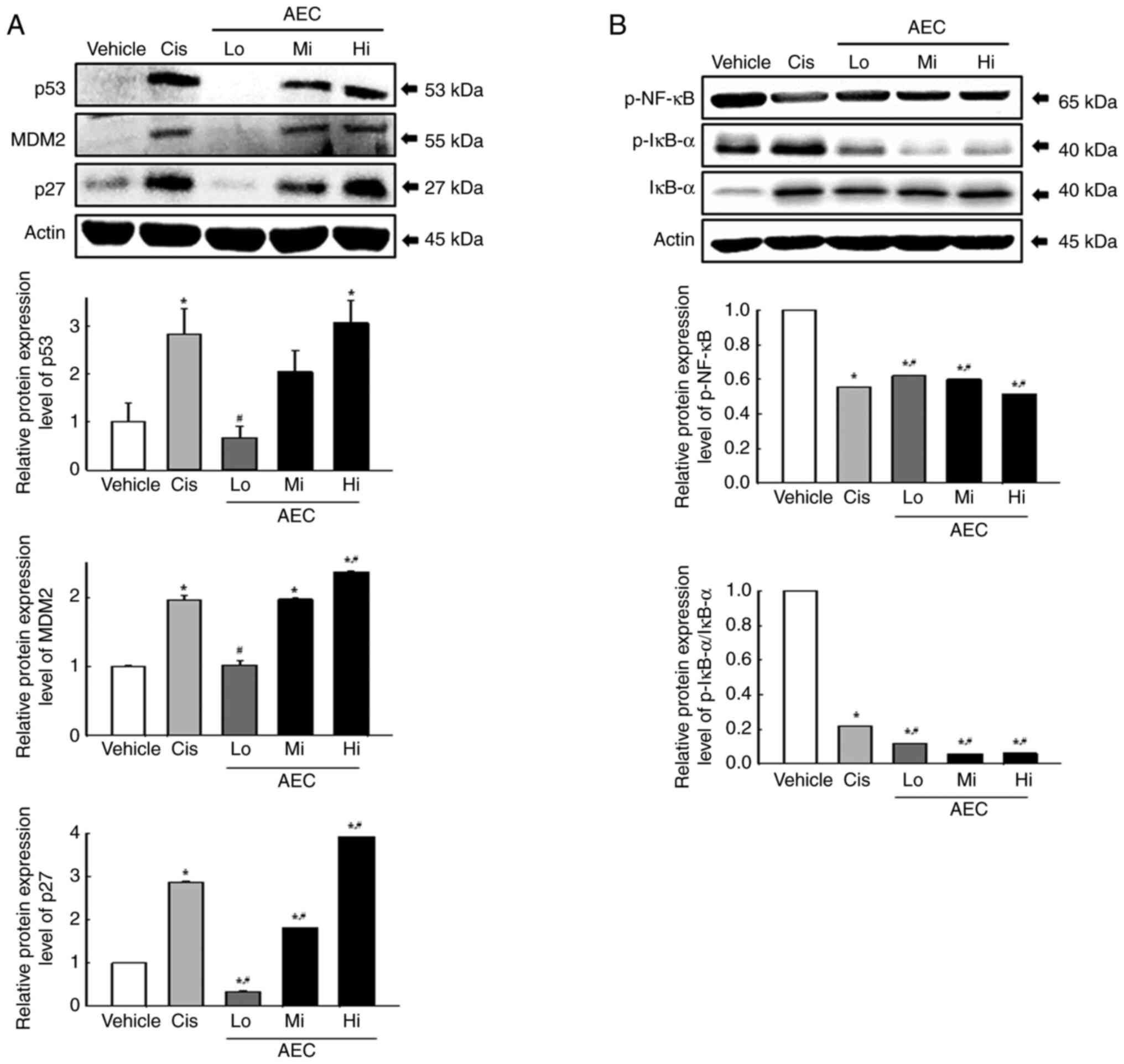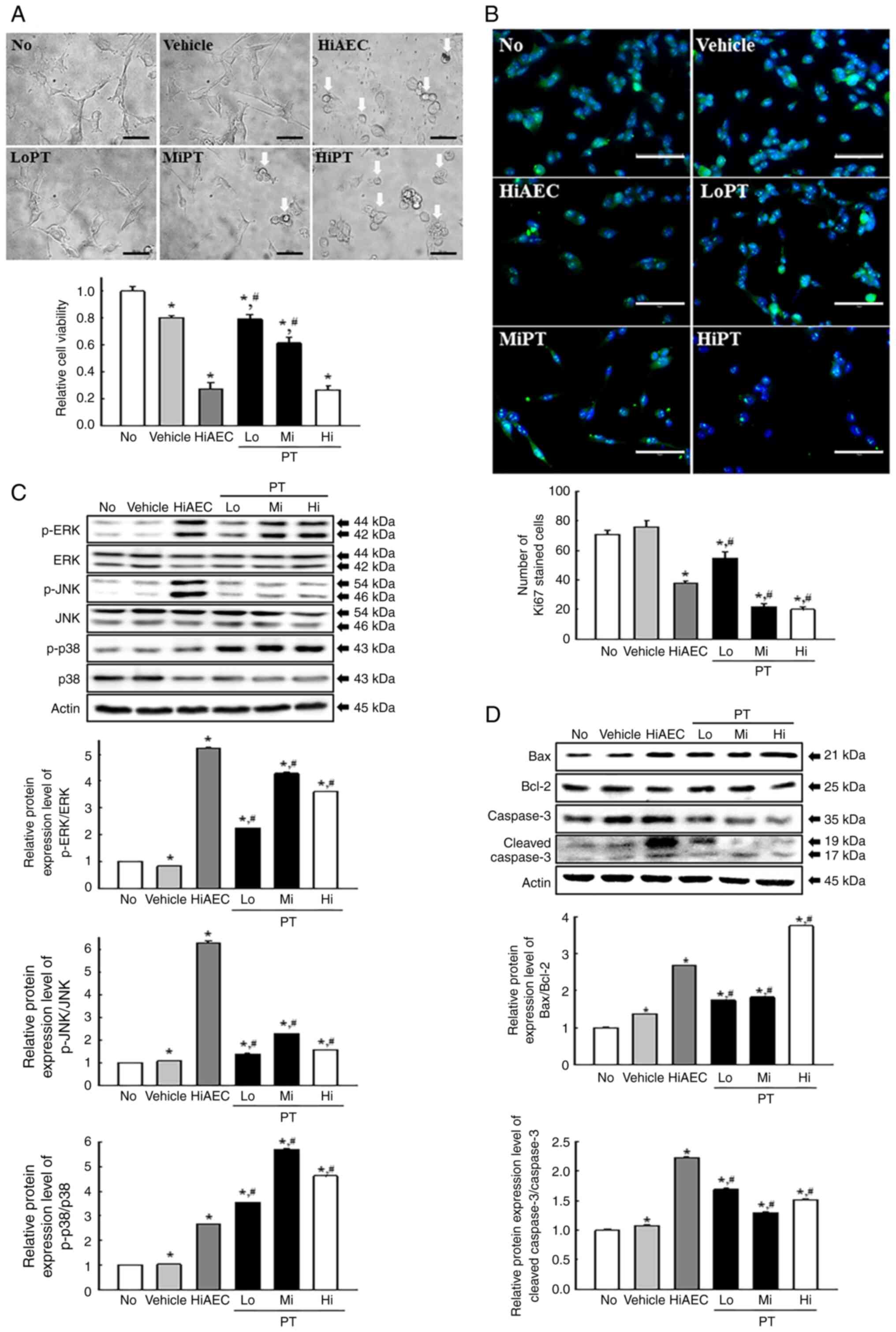|
1
|
Maegawa M, Yokohoma Y and Aruga Y:
Critical light conditions for young Ecklonia cava and
Eisenia bicyclis with reference to photosynthesis.
Hydrobiologia. 151:447–455. 1987. View Article : Google Scholar
|
|
2
|
Heo SJ, Park EJ, Lee KW and Jeon YJ:
Antioxidant activities of enzymatic extracts from brown seaweeds.
Bioresour Technol. 96:1613–1623. 2005. View Article : Google Scholar : PubMed/NCBI
|
|
3
|
Kang KA, Lee KH, Chae S, Zhang R, Jung MS,
Lee Y, Kim SY, Kim HS, Joo HG, Park JW, et al: Eckol isolated from
Ecklonia cava attenuates oxidative stress induced cell
damage in lung fibroblast cells. FEBS Lett. 579:6295–6304. 2005.
View Article : Google Scholar : PubMed/NCBI
|
|
4
|
Ahn GN, Kim KN, Cha SH, Song CB, Lee J,
Heo MS, Yeo IK, Lee NH, Jee YH, Kim JS, et al: Antioxidant
activities of phlorotannins purified from Ecklonia cava on
free radical scavenging using ESR and
H2O2-mediated DNA damage. Eur Food Res
Technol. 226:71–79. 2007. View Article : Google Scholar
|
|
5
|
Li Y, Qian ZJ, Ryu B, Lee SH, Kim MM and
Kim SK: Chemical components and its antioxidant properties in
vitro: An edible marine brown alga, Ecklonia cava. Bioorg
Med Chem. 17:1963–1973. 2009. View Article : Google Scholar : PubMed/NCBI
|
|
6
|
Artan M, Li Y, Karadeniz F, Lee SH, Kim MM
and Kim SK: Anti-HIV-1 activity of phloroglucinol derivative,
6,6′-bieckol, from Ecklonia cava. Bioorg Med Chem.
16:7921–7926. 2008. View Article : Google Scholar : PubMed/NCBI
|
|
7
|
Kong CS, Kim JA, Yoon NY and Kim SK:
Induction of apoptosis by phloroglucinol derivative from
Ecklonia cava in MCF-7 human breast cancer cells. Food Chem
Toxicol. 47:1653–1658. 2009. View Article : Google Scholar : PubMed/NCBI
|
|
8
|
Athukorala Y and Jeon YJ: Screening for
angiotensin 1-converting enzyme inhibitory activity of Ecklonia
cava. Prev Nutr Food Sci. 10:134–139. 2005. View Article : Google Scholar
|
|
9
|
Jung WK, Ahn YW, Lee SH, Choi YH, Kim SK,
Yea SS, Choi I, Park SG, Seo SK, Lee SW and Choi IW: Ecklonia
cava ethanolic extracts inhibit lipopolysaccharide-induced
cyclooxygenase-2 and inducible nitric oxide synthase expression in
BV2 microglia via the MAP kinase and NF-kappaB pathways. Food Chem
Toxicol. 47:410–417. 2009. View Article : Google Scholar : PubMed/NCBI
|
|
10
|
Lee SH, Li Y, Karadeniz F, Kim MM and Kim
SK: α-Glycosidase and α-amylase inhibitory activities of
phloroglucinal derivatives from edible marine brown alga,
Ecklonia cava. J Sci Food Agric. 89:1552–1558. 2009.
View Article : Google Scholar
|
|
11
|
Ahn JH, Yang YI, Lee KT and Choi JH:
Dieckol, isolated from the edible brown algae Ecklonia cava,
induces apoptosis of ovarian cancer cells and inhibits tumor
xenograft growth. J Cancer Res Clin Oncol. 141:255–268. 2015.
View Article : Google Scholar : PubMed/NCBI
|
|
12
|
Zhang C, Li Y, Shi X and Kim SK:
Inhibition of the expression on MMP-2, 9 and morphological changes
via human fibrosarcoma cell line by 6,6′-bieckol from marine alga
Ecklonia cava. BMB Rep. 43:62–68. 2010. View Article : Google Scholar : PubMed/NCBI
|
|
13
|
Kim EK, Tang Y, Kim YS, Hwang JW, Choi EJ,
Lee JH, Lee SH, Jeon YJ and Park PJ: First evidence that
Ecklonia cava-derived dieckol attenuates MCF-7 human breast
carcinoma cell migration. Mar Drugs. 13:1785–1797. 2015. View Article : Google Scholar : PubMed/NCBI
|
|
14
|
Sadeeshkumar V, Duraikannu A, Ravichandran
S, Kodisundaram P, Fredrick WS and Gobalakrishnan R: Modulatory
efficacy of dieckol on xenobiotic-metabolizing enzymes, cell
proliferation, apoptosis, invasion and angiogenesis during
NDEA-induced rat hepatocarcinogenesis. Mol Cell Biochem.
433:195–204. 2017. View Article : Google Scholar : PubMed/NCBI
|
|
15
|
Athukorala Y, Kim KN and Jeon YJ:
Antiproliferative and antioxidant properties of an enzymatic
hydrolysate from brown alga, Ecklonia cava. Food Chem
Toxicol. 44:1065–1074. 2006. View Article : Google Scholar : PubMed/NCBI
|
|
16
|
Ahn G, Lee W, Kim KN, Lee JH, Heo SJ, Kang
N, Lee SH, Ahn CB and Jeon YJ: A sulfated polysaccharide of
Ecklonia cava inhibits the growth of colon cancer cells by
inducing apoptosis. EXCLI J. 14:294–306. 2015.PubMed/NCBI
|
|
17
|
Kim JE, Choi YJ, Lee SJ, Gong JE, Lee YJ,
Sung JE, Jung YS, Lee HS, Hong JT and Hwang DY: Antioxidant
activity and laxative effects of tannin-enriched extract of
Ecklonia cava in loperamide-induced constipation of SD rats.
PLoS One. 16:e02463632021. View Article : Google Scholar : PubMed/NCBI
|
|
18
|
Lee HS, Kim SW, Oak C, Kang HW, Oh J, Jung
MJ, Kim SB, Won JH and Lee KD: Rabbit model of tracheal stenosis
using cylindrical diffuser. Lasers Surg Med. 49:372–379. 2017.
View Article : Google Scholar : PubMed/NCBI
|
|
19
|
Lee HS, Jeong MS, Ko SC, Heo SY, Kang HW,
Kim SW, Hwang CW, Lee KD, Oak C, Jung MJ, et al: Fabrication and
biological activity of polycaprolactone/phlorotannin endotracheal
tube to prevent tracheal stenosis: An in vitro and in vivo study. J
Biomed Mater Res B Appl Biomater. 108:1046–1056. 2020. View Article : Google Scholar : PubMed/NCBI
|
|
20
|
Gutfinger T: Polyphenols in olive oils. J
Am Oil Chem Soc. 58:966–968. 1981. View Article : Google Scholar
|
|
21
|
Xu ML, Hu JH, Wang L, Kim HS, Jin CW and
Cho DH: Antioxidant and anti-diabetes activity of extracts from
Machilus thunbergii S. et Z. Korean J Medicinal Crop Sci.
18:34–39. 2010.
|
|
22
|
Price ML, Hagerman AE and Butler LG:
Tannin content of cowpeas, chickpeas, pigeon peas, and mung beans.
J Agric Food Chem. 28:459–461. 1980. View Article : Google Scholar : PubMed/NCBI
|
|
23
|
Go J, Kim JE, Koh EK, Song SH, Sung JE,
Lee HA, Lee YH, Lim Y, Hong JT and Hwang DY: Protective effect of
gallotannin-enriched extract isolated from Galla rhois
against CCl4-induced hepatotoxicity in ICR mice. Nutrients.
8:1072016. View Article : Google Scholar : PubMed/NCBI
|
|
24
|
Catarino MD, Fernandes I, Oliveira H,
Carrascal M, Ferreira R, Silva AMS, Cruz MT, Mateus N and Cardoso
SM: Antitumor activity of Fucus vesiculosus-derived
phlorotannins through activation of apoptotic signals in gastric
and colorectal tumor cell lines. Int J Mol Sci. 22:76042021.
View Article : Google Scholar : PubMed/NCBI
|
|
25
|
Yu JW, Bhattacharya S, Yanamandra N,
Kilian D, Shi H, Yadavilli S, Katlinskaya Y, Kaczynski H, Conner M,
Benson W, et al: Tumor-immune profiling of murine syngeneic tumor
models as a framework to guide mechanistic studies and predict
therapy response in distinct tumor microenvironments. PLoS One.
13:e02062232018. View Article : Google Scholar : PubMed/NCBI
|
|
26
|
Hsieh YH, Wu CJ, Chow KP, Tsai CL and
Chang YS: Electroporation-mediated and EBV LMP1-regulated gene
therapy in a syngenic mouse tumor model. Cancer Gene Ther.
10:626–636. 2003. View Article : Google Scholar : PubMed/NCBI
|
|
27
|
Park HR, Jo SK, Cho HH and Jung U:
Synergistic Anti-cancer Activity of MH-30 in a murine melanoma
model treated with cisplatin and its alleviated effects against
cisplatin-induced toxicity in mice. In Vivo. 34:1845–1856. 2020.
View Article : Google Scholar : PubMed/NCBI
|
|
28
|
Noto FK, Sangodkar J, Adedeji BT, Moody S,
McClain CB, Tong M, Ostertag E, Crawford J, Gao X, Hurst L, et al:
The SRG rat, a Sprague-Dawley Rag2/Il2rg double-knockout validated
for human tumor oncology studies. PLoS One. 15:e02401692020.
View Article : Google Scholar : PubMed/NCBI
|
|
29
|
Na K, Li K, Sang T, Wu K, Wang Y and Wang
X: Anticarcinogenic effects of water extract of sporoderm-broken
spores of Ganoderma lucidum on colorectal cancer in
vitro and in vivo. Int J Oncol. 50:1541–1554. 2017.
View Article : Google Scholar : PubMed/NCBI
|
|
30
|
Erickson RL, Blevins CE, Souza Dyer C and
Marx JO: Alfaxalone-Xylazine anesthesia in laboratory mice (Mus
musculus). J Am Assoc Lab Anim Sci. 58:30–39. 2019. View Article : Google Scholar : PubMed/NCBI
|
|
31
|
Best I, Casimiro-Gonzales S, Portugal A,
Olivera-Montenegro L, Aguilar L, Muñoz AM and Ramos-Escudero F:
Phytochemical screening and DPPH radical scavenging activity of
three morphotypes of Mauritia flexuosa L.f. from Peru, and
thermal stability of a milk-based beverage enriched with
carotenoids from these fruits. Heliyon. 6:e052092020. View Article : Google Scholar : PubMed/NCBI
|
|
32
|
Mazumder K, Nabila A, Aktar A and
Farahnaky A: Bioactive variability and in vitro and in vivo
antioxidant activity of unprocessed and processed flour of nine
cultivars of Australian lupin species: A comprehensive
substantiation. Antioxidants (Basel). 9:2822020. View Article : Google Scholar : PubMed/NCBI
|
|
33
|
Liu DZ, Lin YS and Hou WC:
Monohydroxamates of aspartic acid and glutamic acid exhibit
antioxidant and angiotensin converting enzyme inhibitory
activities. J Agric Food Chem. 52:2386–2390. 2004. View Article : Google Scholar : PubMed/NCBI
|
|
34
|
Manandhar B, Paudel P, Seong SH, Jung HA
and Coi JS: Characterizing eckol as a therapeutic aid: A systematic
review. Mar Drugs. 17:3612019. View Article : Google Scholar : PubMed/NCBI
|
|
35
|
Fernando IP, Kim M, Son KT, Jeong Y and
Jeon YJ: Antioxidant activity of marine algal polyphenolic
compounds: A mechanistic approach. J Med Food. 19:615–628. 2016.
View Article : Google Scholar : PubMed/NCBI
|
|
36
|
Li Y, Wijesekara I, Li Y and Kim S:
Phlorotannins as bioactive agents from brown algae. Process
Biochem. 46:2219–2224. 2011. View Article : Google Scholar
|
|
37
|
Aristri MA, Lubis MAR, Iswanto AH,
Fatriasari W, Sari RK, Antov P, Gajtanska M, Papadopoulos AN and
Pizzi A: Bio-based polyurethane resins derived from tannin: Source,
synthesis, characterization, and application. Forests.
12:1516–1538. 2021. View Article : Google Scholar
|
|
38
|
Chung KT, Wong TY, Wei CI, Huang YW and
Lin Y: Tannins and human health: A review. Crit Rev Food Sci Nutr.
38:421–464. 1998. View Article : Google Scholar : PubMed/NCBI
|
|
39
|
Cho HM, Doan TP, Ha TKQ, Kim HW, Lee BW,
Pham HTT, Cho TO and Oh WK: Dereplication by high-performance
liquid chromatography (HPLC) with quadrupole-time-of-flight mass
spectroscopy (qTOF-MS) and antiviral activities of phlorotannins
from Ecklonia cava. Mar Drugs. 17:1492019. View Article : Google Scholar : PubMed/NCBI
|
|
40
|
Lee JH, Ko JY, Oh JY, Kim CY, Lee HJ, Kim
J and Jeon YJ: Preparative isolation and purification of
phlorotannins from Ecklonia cava using centrifugal partition
chromatography by one-step. Food Chem. 158:433–437. 2014.
View Article : Google Scholar : PubMed/NCBI
|
|
41
|
Lee JW, Seok JK and Boo YC: Ecklonia
cava extract and dieckol attenuate cellular lipid peroxidation
in keratinocytes exposed to PM10. Evid Based Complement Alternat
Med. 2018:82483232018.PubMed/NCBI
|
|
42
|
Govindappa M, Lavanya M, Aishwarya P, Pai
K, Lunked P, Hemashekhar B, Arpitha BM, Ramachandra YL and
Raghavendra VB: Synthesis and characterization of endophytic fungi,
Cladosporium perangustum mediated silver nano-particles and
their antioxidant, anticancer and nano-toxicological study.
Bionanoscience. 10:928–941. 2020. View Article : Google Scholar
|
|
43
|
Kurian GA and Paddikkala J: Oral delivery
of insulin with Desmodium gangeticum root aqueous extract
protects rat hearts against ischemia reperfusion injury in
streptozotocin induced diabetic rats. Asian Pac J Trop Med.
3:94–100. 2010. View Article : Google Scholar
|
|
44
|
Baig S, Seevasant I, Mohamad J, Mukheem A,
Huri HZ and Kamarul T: Potential of apoptotic pathway-targeted
cancer therapeutic research: Where do we stand? Cell Death Dis.
7:e20582016. View Article : Google Scholar : PubMed/NCBI
|
|
45
|
Vitagliano O, Addeo R, D'Angelo V, Indolfi
C, Indolfi P and Casale F: The Bcl-2/Bax and Ras/Raf/MEK/ERK
signaling pathways: Implications in pediatric leukemia pathogenesis
and new prospects for therapeutic approaches. Expert Rev Hematol.
6:587–597. 2013. View Article : Google Scholar : PubMed/NCBI
|
|
46
|
Kwon YH, Jung SY, Kim JW, Lee SH, Lee JH,
Lee BY and Kwon SM: Phloroglucinol inhibits the bioactivities of
endothelial progenitor cells and suppresses tumor angiogenesis in
LLC-tumor-bearing mice. PLoS One. 7:e336182012. View Article : Google Scholar : PubMed/NCBI
|
|
47
|
Yang YI, Ahn JH, Choi YS and Choi JH:
Brown algae phlorotannins enhance the tumoricidal effect of
cisplatin and ameliorate cisplatin nephrotoxicity. Gynecol Oncol.
136:355–364. 2015. View Article : Google Scholar : PubMed/NCBI
|
|
48
|
Juríková M, Danihel Ľ, Polák Š and Varga
I: Ki67, PCNA, and MCM proteins: Markers of proliferation in the
diagnosis of breast cancer. Acta Histochem. 118:544–552. 2016.
View Article : Google Scholar : PubMed/NCBI
|
|
49
|
Alexandrakis MG, Passam FH, Kyriakou DS,
Dambaki K, Niniraki M and Stathopoulos E: Ki-67 proliferation
index: Correlation with prognostic parameters and outcome in
multiple myeloma. Am J Clin Oncol. 27:8–13. 2004. View Article : Google Scholar : PubMed/NCBI
|
|
50
|
Li R, Heydon K, Hammond ME, Grignon DJ,
Roach M III, Wolkov HB, Sandler HM, Shipley WU and Pollack A: Ki-67
staining index predicts distant metastasis and survival in locally
advanced prostate cancer treated with radiotherapy: An analysis of
patients in radiation therapy oncology group protocol 86–10. Clin
Cancer Res. 10:4118–4124. 2004. View Article : Google Scholar : PubMed/NCBI
|
|
51
|
Urruticoechea A, Smith IE and Dowsett M:
Proliferation marker Ki-67 in early breast cancer. J Clin Oncol.
23:7212–7220. 2005. View Article : Google Scholar : PubMed/NCBI
|
|
52
|
Abd Eldaim MA, Tousson E, El Sayed IET,
Abd El-Aleim AEH and Elsharkawy HN: Grape seeds proanthocyanidin
extract ameliorates Ehrlich solid tumor induced renal tissue and
DNA damage in mice. Biomed Pharmacother. 115:1089082019. View Article : Google Scholar : PubMed/NCBI
|
|
53
|
Al-Halabi R, Bou Chedid M, Abou Merhi R,
El-Hajj H, Zahr H, Schneider-Stock R, Bazarbachi A and
Gali-Muhtasib H: Gallotannin inhibits NFĸB signaling and growth of
human colon cancer xenografts. Cancer Biol Ther. 12:59–68. 2011.
View Article : Google Scholar : PubMed/NCBI
|
|
54
|
Kimura Y and Sumiyoshi M: French maritime
pine bark (Pinus maritima Lam.) extract (Flavangenol)
prevents chronic UVB radiation-induced skin damage and
carcinogenesis in melanin-possessing hairless mice. Photochem
Photobiol. 86:955–963. 2010. View Article : Google Scholar : PubMed/NCBI
|
|
55
|
Folkman J and Shing Y: Angiogenesis. J
Biol Chem. 267:10931–10934. 1992. View Article : Google Scholar : PubMed/NCBI
|
|
56
|
Martin TA and Jiang WG: Loss of tight
junction barrier function and its role in cancer metastasis.
Biochim Biophys Acta. 1788:872–891. 2009. View Article : Google Scholar : PubMed/NCBI
|
|
57
|
Kim D, Kim S, Koh H, Yoon SO, Chung AS,
Cho KS and Chung J: Akt/PKB promotes cancer cell invasion via
increased motility and metalloproteinase production. FASEB J.
15:1953–1962. 2001. View Article : Google Scholar : PubMed/NCBI
|
|
58
|
Yang SX, Polley E and Lipkowitz S: New
insights on PI3K/AKT pathway alterations and clinical outcomes in
breast cancer. Cancer Treat Rev. 45:87–96. 2016. View Article : Google Scholar : PubMed/NCBI
|
|
59
|
Zhang C, Li Y, Qian ZJ, Lee SH, Li YX and
Kim SK: Dieckol from Ecklonia cava regulates invasion of
human fibrosarcoma cells and modulates MMP-2 and MMP-9 expression
via NF-κB pathway. Evid Based Complement Alternat Med.
2011:1404622011. View Article : Google Scholar : PubMed/NCBI
|
|
60
|
Park SJ and Jeon YJ: Dieckol from
Ecklonia cava suppresses the migration and invasion of
HT1080 cells by inhibiting the focal adhesion kinase pathway
downstream of Rac1-ROS signaling. Mol Cells. 33:141–149. 2012.
View Article : Google Scholar : PubMed/NCBI
|
|
61
|
Wang CH, Li XF, Jin LF, Zhao Y, Zhu GJ and
Shen WZ: Dieckol inhibits non-small-cell lung cancer cell
proliferation and migration by regulating the PI3K/AKT signaling
pathway. J Biochem Mol Toxicol. 33:e223462019. View Article : Google Scholar : PubMed/NCBI
|
|
62
|
Gudkov AV, Gurova KV and Komarova EA:
Inflammation and p53: A tale of two stresses. Genes Cancer.
2:503–516. 2011. View Article : Google Scholar : PubMed/NCBI
|
|
63
|
Lane D and Levine A: p53 Research: The
past thirty years and the next thirty years. Cold Spring Harb
Perspect Biol. 2:a0008932010. View Article : Google Scholar : PubMed/NCBI
|
|
64
|
Karin M: Nuclear factor-kappaB in cancer
development and progression. Nature. 441:431–436. 2006. View Article : Google Scholar : PubMed/NCBI
|
|
65
|
Levine AJ and Oren M: The first 30 years
of p53: Growing ever more complex. Nat Rev Cancer. 9:749–758. 2009.
View Article : Google Scholar : PubMed/NCBI
|
|
66
|
Kawauchi K, Araki K, Tobiume K and Tanaka
N: Loss of p53 enhances catalytic activity of IKKbeta through
O-linked beta-N-acetyl glucosamine modification. Proc Natl Acad Sci
USA. 106:3431–3436. 2009. View Article : Google Scholar : PubMed/NCBI
|
|
67
|
Pal Singh I and Bharate SB: Phloroglucinol
compounds of natural origin. Nat Prod Rep. 23:558–591. 2006.
View Article : Google Scholar : PubMed/NCBI
|
|
68
|
Yoon NY, Chung HY, Kim H and Choi J:
Acetyl- and butyrylcholinesterase inhibitory activities of sterols
and phlorotannins from Ecklonia stolonifera. Fish Sci.
74:200–207. 2008. View Article : Google Scholar
|
|
69
|
Nagayama K, Shibata T, Fujimoto K, Honjo T
and Nakamura T: Algicidal effect of phlorotannins from the brown
alga Ecklonia kurome on red tide microalgae. Aquaculture.
218:601–611. 2003. View Article : Google Scholar
|
|
70
|
Yoon NY: Cholinestarase and lens aldose
reductase inhibitory activities of phlorotannins from Ecklonia
stolonifera and their protective effects on tacrine induced
hepatotoxicity and hyperlipidemic rat models. Ph.D. Thesis, Pukyong
National University, Korea. 4:1112008.
|
|
71
|
Kim MM, Ta QV, Mendis E, Rajapakse N, Jung
WK, Byun HG, Jeon YJ and Kim SK: Phlorotannins in Ecklonia
cava extract inhibit matrix metalloproteinase activity. Life
Sci. 79:1436–1443. 2006. View Article : Google Scholar : PubMed/NCBI
|
|
72
|
Sanjeewa KKA, Fernando IPS, Kim SY, Kim
WS, Ahn G, Jee Y and Jeon YJ: Ecklonia cava (Laminariales)
and Sargassum horneri (Fucales) synergistically inhibit the
lipopolysaccharide-induced inflammation via blocking NF-κB and MAPK
pathways. Algae. 34:45–56. 2019. View Article : Google Scholar
|
|
73
|
You SH, Kim JS and Kim YS: Apoptosis and
cell cycle arrest in two human breast cancer cell lines by dieckol
isolated from Ecklonia cava. J Breast Dis. 6:39–45. 2018.
View Article : Google Scholar
|
|
74
|
Yang H, Lee SY, Lee SR, Pyun BJ, Kim HJ,
Lee YH, Kwon SW, Suh DH, Lee CH, Hong EJ and Lee HW: Therapeutic
effect of Ecklonia cava extract in letrozole-induced
polycystic ovary syndrome rats. Front Pharmacol. 9:13252018.
View Article : Google Scholar : PubMed/NCBI
|
















